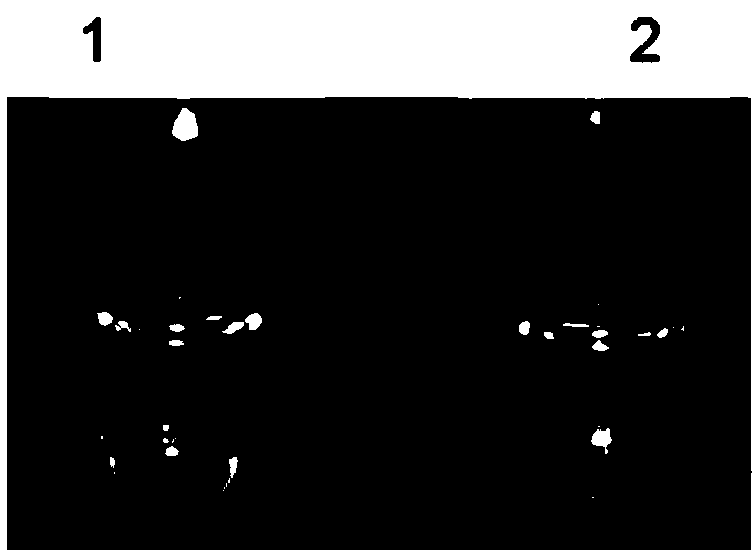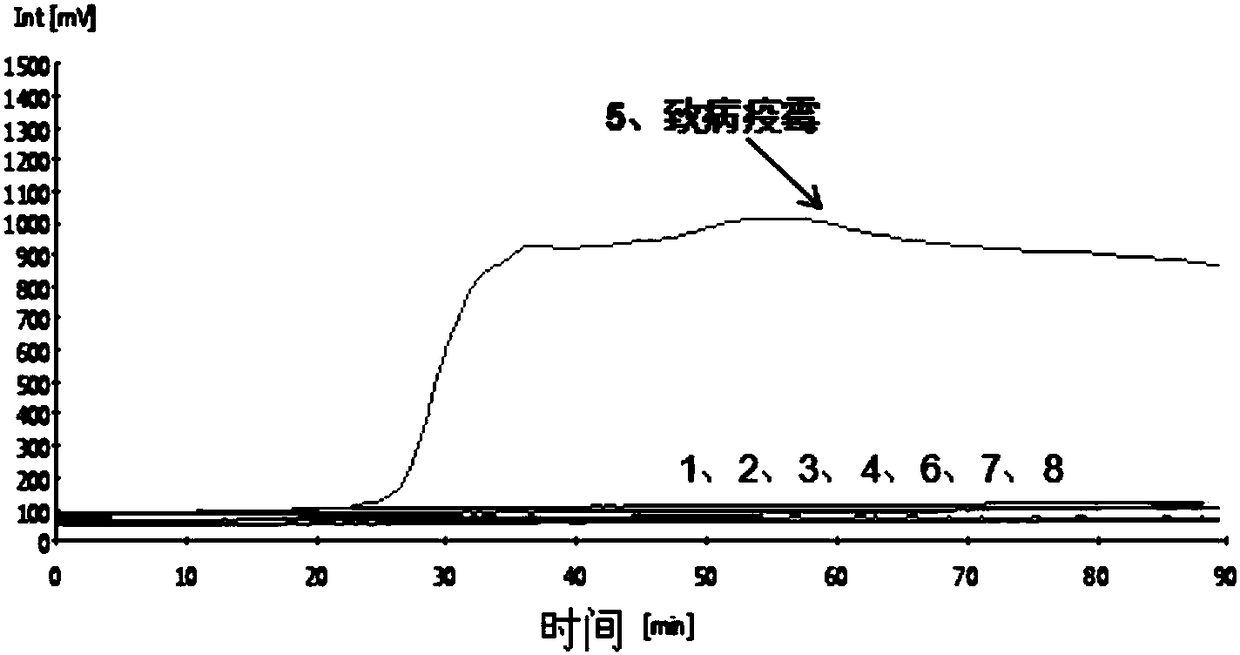Real-time fluorescent LAMP detection method and kit for Phytophthora infestans
A potato late blight and real-time fluorescence technology, applied in the field of molecular biology, can solve the problems of contamination of amplification products, time-consuming and labor-intensive, etc., and achieve the effects of high sensitivity, ensuring accuracy, and convenient and fast detection methods.
- Summary
- Abstract
- Description
- Claims
- Application Information
AI Technical Summary
Problems solved by technology
Method used
Image
Examples
Embodiment 1
[0056] Example 1 Real-time fluorescent LAMP detection primer set for P. infestans
[0057] Homology analysis was performed on the Ypt1 gene sequence of P. infestans Ypt1 retrieved from Genebank (accession number DQ162961), and the species conservation region was determined. The primer design software primerexplorer V4 (https: / / primerexplorer.jp / elamp4.0.0 / index.html) was used to design LAMP primers, and 1000 pairs of primer sequences were obtained.
[0058] The presence or absence of primer dimers and neck ring structure analysis on the primers by DNAMAN, and through ordinary PCR and LAMPPCR experiments, 6 primers with strong specificity and high sensitivity were selected to form the primer set of the present invention, including:
[0059] Two outer primers:
[0060] F3: 5'-CAAGACCATCAAGCTCCAA-3';
[0061] B3: 5'-GTCCGTCACATCGTACAC-3';
[0062] Two inner primers:
[0063] FIP: 5'-TCACGCGGGGACAAATGTTGTACGCCGTACCATCAAG-3';
[0064] BIP: 5'-TTCAACAGTGGGACACTGCCGATAATACCGTGGG...
Embodiment 2
[0068] The detection of embodiment 2 potato infestation bacteria
[0069] 1. Collection of Phytophthora infestans Bacteria and Extraction of Genomic DNA
[0070] The Phytophthora infestans strain was cultured on rye medium, and the hyphae were collected after 10 days. Genomic DNA was extracted by the modified CTAB method. The obtained DNA was used as a LAMP template.
[0071] 2. 25 μL fluorescent modified LAMP reaction system
[0072] 25 μL fluorescence-modified LAMP reaction system: 25 μL reaction system, inner primer 1.2 μM, outer primer 0.32 μM, loop primer 0.68 μM, dNTPs 1.8 mM, MgSO 4 1.5mM, 8U / μL Bst DNA polymerase, 3.2μL, 10×ThermoPolReaction Buffer (New England Biolabs, MA) (20mM Tris-HCl (pH 8.8), 10mM KCl, 10mM (NH4)2SO 4 , 2mM MgSO 4 , 0.1% Triton X-100) 2.5 μL, 8U / μL Bst DNA polymerase 3.2 μL, DNA template 2 μL, 50×SYBR Green Ⅰ 0.3 μL, ddH 2 O to make up to 25 μL.
[0073] 3. Judgment of amplification and detection results
[0074] ①The LAMP reaction syste...
Embodiment 3
[0084] Example 3 Optimization of real-time fluorescent LAMP reaction system
[0085] (1) Screening of optimum betaine concentration
[0086] Betaine (50mol·L -1 ) respectively set 7 different treatments such as 0μL, 0.5μL, 1.0μL, 1.5μL, 2.0μL, 2.5μL, 3.0μL, and the amplification curves are arranged from top to bottom according to the fluorescence value as follows Figure 4 As shown, the test results show that the earliest peak is without betaine, so it is determined that the optimum amount of betaine added is 0 μL.
[0087] (2) Optimum Mg 2+ concentration screening
[0088] Mg 2+ (50mmol·L -1 MgSO 4 ) with 7 different treatments at final concentrations of 0.25 μL, 0.5 μL, 1.0 μL, 1.5 μL, 2.0 μL, 2.5 μL, and 3.0 μL, and the amplification curves are arranged from top to bottom according to the fluorescence values as follows: Figure 5 As shown, the test results show that the earliest peak is 1.5μL, so it is determined that MgSO 4 The optimal amount to add is 1.5 μL.
...
PUM
 Login to View More
Login to View More Abstract
Description
Claims
Application Information
 Login to View More
Login to View More - R&D
- Intellectual Property
- Life Sciences
- Materials
- Tech Scout
- Unparalleled Data Quality
- Higher Quality Content
- 60% Fewer Hallucinations
Browse by: Latest US Patents, China's latest patents, Technical Efficacy Thesaurus, Application Domain, Technology Topic, Popular Technical Reports.
© 2025 PatSnap. All rights reserved.Legal|Privacy policy|Modern Slavery Act Transparency Statement|Sitemap|About US| Contact US: help@patsnap.com



